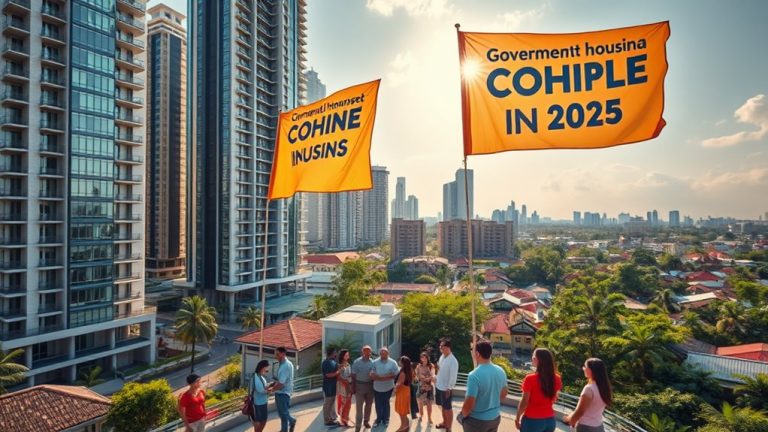You might not realize that the interplay between state policies and home financing can dramatically shape the housing landscape in Malaysia. As we approach 2025, diverse government initiatives are set to redefine affordability and accessibility, impacting not just potential homeowners but the entire economy. With significant investments in infrastructure and evolving sustainability measures, the landscape is changing rapidly. What strategies are being implemented, and how will they affect your opportunities in the housing market?
Government Support Initiatives
In Malaysia, government support initiatives play a crucial role in making home financing more accessible. You might feel overwhelmed by the thought of buying a home, but you're not alone.
The government has allocated RM900 million for the Peoples Housing Program, aiming to help around 17,500 residents access affordable housing by the end of 2025. That's a step in the right direction, isn't it?
The Home Ownership Campaign (HOC) is another lifeline, offering a 100% stamp duty exemption for novice homebuyers on properties priced between RM300,001 and RM1 million.
Plus, there's a one-time RM30,000 grant for homes up to RM500,000. These incentives make homeownership feel less like a distant dream.
Then there's the Step Up Financing Scheme, with RM5 billion aimed at easing the burden for young buyers. You see, they really want to help you get your initial home.
And if you're in the M40 income group, proposals suggest you could benefit too, with a potential 75% stamp duty exemption on homes priced between RM500,000 and RM1 million.
This is all about opening doors and ensuring you feel secure in your housing experience. Moreover, these initiatives align with the government's focus on affordable housing to enhance community living standards.
Housing Affordability Challenges
Housing affordability poses a significant challenge for many Malaysians, especially with the increasing demand driven by rapid urbanization and changing family structures.
It's frustrating to see so many people struggling to find homes that fit their budgets, while the prices keep rising.
- The gap between housing supply and demand is widening.
- Only 197,649 low-cost housing units were built, while 230,000 were needed.
- Urban areas like Kuala Lumpur and Penang face the toughest affordability issues.
- Many middle-income families can't keep up with skyrocketing prices.
You might feel a mix of disappointment and concern knowing that despite government efforts like Projek Perumahan Rakyat 1 Malaysia (PR1Ma), the mismatch between available affordable housing and what families can actually afford persists.
It's disheartening to see that Malaysia's median house price-to-income ratio has been over 4.0 for years, making it harder for young families to secure a safe and comfortable home.
As the demand continues to grow, it's clear that we need more effective solutions to bridge this gap and guarantee everyone has access to affordable housing. Furthermore, the Sale Demand Index has decreased since 2021, highlighting the ongoing challenges in meeting housing needs.
Infrastructure Development Impact

With the government's strong push for infrastructure development, home financing in Malaysia is set to benefit greatly. You mightn't realize it, but the RM127.36 billion invested in infrastructure, including RM33.5 billion from government funds, is a game-changer. This commitment is vital for stimulating the housing market and improving your financing options.
Take the MRT3 project, for instance. It's designed to make suburban living more accessible. Imagine being able to reach your workplace easily while enjoying more affordable housing options.
Plus, with RM120 billion projected for public investment, newly developed areas will likely see property values soar. This means more opportunities for you when looking for a home.
Key projects like the Penang Light Rail Transit are also essential. They're not just about getting from point A to B; they're about uplifting local economies.
This, in turn, amplifies the financial capacity of residents like you, making it easier to secure home loans. With government spending aimed at alleviating housing supply constraints, the conditions for home financing are looking up.
It's a step in the right direction for anyone seeking safety and stability in their housing experience.
Sustainability and Green Policies
Sustainability is becoming a cornerstone of home financing in Malaysia, driven by government initiatives that promote green building practices. It's not just a trend anymore; it's crucial for our future. You might wonder how this affects you, especially when looking for a safe and comfortable home.
Here's what's happening:
- The government offers incentives for energy-efficient technologies in housing.
- Developers are encouraged to adopt green building designs that meet international standards.
- Tax breaks for projects that integrate sustainable practices are on the table.
- Collaborative efforts between public and private sectors are gaining momentum.
But it's frustrating because, while these initiatives sound great on paper, many affordable housing projects still struggle to meet these green standards.
Datuk Wong Tuck Wai from IJM Land Bhd stresses that without proper support, it's tough to balance environmental goals with housing needs. You want to feel secure in your home, knowing it's built to last and won't break the bank on utility bills.
Moreover, understanding down payment requirements can help prospective homeowners make informed decisions about financing their green homes.
If we want a safer future, we must push harder for these sustainable practices to be the norm, not just an option.
Market Conditions and Investment Climate

Malaysia's real estate market is currently experiencing a transformative phase, driven by strategic government initiatives and evolving investment climates. You might feel frustrated with the complexities of home financing, but there are positive changes underway.
For instance, the government's blanket waiver on real property gains tax and stamp duty waivers is a significant step to rejuvenate market conditions. These measures aim to enhance investment, making home buying more accessible.
However, it's important to recognize that consistent state policies are fundamental for reducing property overhang. There's a growing call to review property acquisition guidelines for foreign investors, which could attract more funds into the housing market.
Also, with the government investing RM127.36 billion in infrastructure, including RM33.5 billion from public sources, the construction industry is set to flourish, improving conditions for home financing.
Public-private partnerships (PPPs) focused on affordable housing are crucial too. They help guarantee that housing remains available for everyone, regardless of income level.
Furthermore, as the government's initiatives align with lower interest rates, potential homebuyers can benefit from more favorable mortgage conditions. While you might still feel uncertainty in this evolving market, these collaborative efforts could create a safer, more stable environment for future homeowners like you. Your dream of owning a home may be closer than you think.
Frequently Asked Questions
What Is the Property Sector Outlook for 2025 in Malaysia?
The property sector in Malaysia looks promising for 2025, with expected GDP growth and government initiatives aimed at improving housing access. You can anticipate more opportunities for homeownership, especially with new financing schemes and stamp duty exemptions.
What Is the Focus of Budget 2025 in Malaysia?
Imagine a sturdy bridge, built to connect communities; Budget 2025 focuses on strengthening Malaysia's foundation. With RM421 billion allocated, it prioritizes education, healthcare, and housing, ensuring your future feels secure and prosperous.
What Is the Budget 2025 for Malaysia Renewable Energy?
The Budget 2025 emphasizes renewable energy, allocating substantial funds for projects aimed at enhancing energy efficiency. You'll find the government's commitment to sustainable growth reassuring, as it directly addresses climate change and promotes safer energy alternatives.
What Is the ESG Budget 2025 Malaysia?
Imagine planting a tree; the ESG Budget 2025 in Malaysia nurtures sustainable growth with tax incentives for green developments and infrastructure projects, ensuring a safer, eco-friendly future that benefits you and generations to come.
Conclusion
In the end, steering home financing in Malaysia feels a bit like trying to catch a bus that never arrives. You might have the ticket—thanks to government schemes—but if the bus doesn't show, you're still left waiting. While policies like the Home Ownership Campaign promise hope, the reality of rising prices and a tight market can be disheartening. As we move toward 2025, the challenge remains: turning those promises into real opportunities for everyone.
